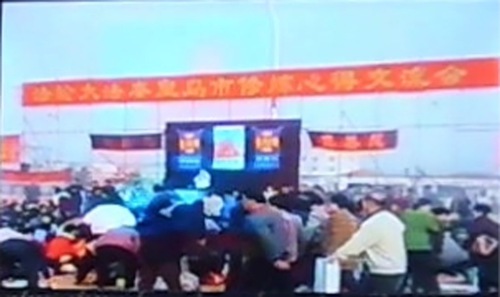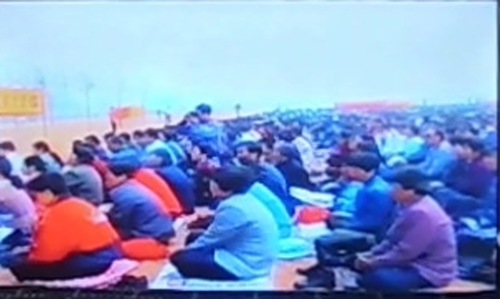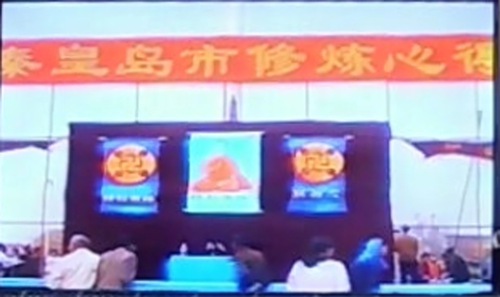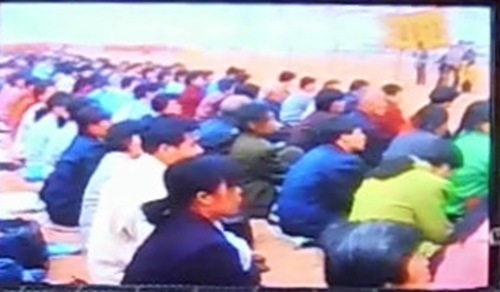(Minghui.org) April 25, 1999, is remembered by Falun Dafa practitioners worldwide as the day that 10,000 practitioners held a peaceful demonstration outside the central government compound in Beijing to demand the basic rights to practice Falun Dafa. On the same day, almost 200 miles east of Beijing, 8,000 practitioners came together for an experience-sharing conference in Qinhuangdao City, Hebei Province.
Back then, the social environment we were facing was hostile and full of difficulties and challenges. Even today, thinking back to how we managed to hold the sharing conference against all odds, many practitioners who attended still feel quite emotional.
Practitioners announced the experience-sharing conference in March 1999. We booked a local stadium for April 25, called for articles, and started reviewing the submissions. Practitioners from all walks of life were encouraged to share about how they follow the principles of Falun Dafa in their working environment — how soldiers, judges, managers, teachers, and business owners became altruistic and kind and looked for their own shortcomings during conflicts. We removed any articles that did not address cultivation and had political intentions.
The day before the conference, a staff member from the stadium called a practitioner and said the police had demanded they cancel the booking and not let us use the venue. The practitioner tried to explain that at such short notice, it wouldn't be possible to notify the thousands of practitioners who were coming, as few people had landlines, let alone mobile phones.
We panicked and didn't know what to do. Someone suggested renting a private venue in the city, but it was too far from the stadium and not many people knew about it. We decided to look for an alternative place nearby.
Within a short time, we found a sandy beach 300 meters west of the stadium. We thought that if we could build a stage, we could use the beach for the experience-sharing conference. The next challenge was to find a construction team, but by then it was already midday.
The practitioners drove around town looking for construction sites. As soon as they saw one, they would stop and ask the workers if they could build the stage. Most of the people at the sites were regular workers and could not make such a decision.
At the last place, a car drove up to the practitioners. A man got out and asked what they wanted. After listening to them, he said, “I’ll have to look at the place first.” He happened to be the general manager of a construction project.
After he looked at the beach site, he reached an agreement with the practitioners on the format of the stage, type of materials, and the cost. Due to the tight time frame, the construction had to continue into the night. Fortunately, there was a 20-meter high flood light next to the beach, which made the construction site as bright as day. The practitioners stayed and helped until the stage was finished.
There was a toilet a block nearby but it only had four toilets. With so many practitioners coming, that would not be enough. The practitioners used a large rain-proof tarp to build a temporary bathroom and fixed the problem.
Practitioners started arriving for the conference at 6 a.m. They sat on the ground, as instructed. Many of them did not bring a cushion because they did not know about the last-minute change. It was cold and windy on the beach, but most practitioners did not feel cold. After a test of the sound system, the conference started at 9 a.m. Later on, the weather became warm and sunny, and the wind stopped.



 The experience-sharing conference was held in Qinhuangdao City 24 years ago on April 25, 1999.
The experience-sharing conference was held in Qinhuangdao City 24 years ago on April 25, 1999.
Halfway through the conference, the electricity went out. The practitioners found out that someone had cut the wires buried in the sand. Fortunately, the practitioners had a backup power source, and the conference continued. A bit later, a plainclothes policeman found the practitioner who was coordinating and ordered him to stop the conference immediately. The coordinator refused and said that it would end in an hour.
The trouble continued. Officials from the department of parks and forests came and told us to take down the bathroom we had built because it was damaging the lawn. The coordinator explained that the conference would be over in less than an hour, and promised that everything would be restored to its original state. He asked for their understanding and immediately offered to pay for any damage. In the end, nothing happened because the officials knew that we would not cause any problems.
As soon as the conference ended, the police told practitioners that they would be legally liable if the cars leaving caused a traffic jam or accident. We felt that this was a hint from Master (the founder of Falun Dafa) so we asked visiting practitioners and those with cars to exit using the west highway and local practitioners to exit from the east side, joining the city traffic. The conference ended at 11:50 a.m. and all the practitioners had left by 12:15 p.m. without causing any traffic jams or accidents. The conference organizers then cleaned up the beach. The police later told us that with 8,000 participants, it was a miracle that we were able to clean up and leave in 30 minutes. By then, we realized that the people who had been standing around on the beach were all plainclothes police.
In the past 24 years, whenever we think back to this precious event, we are still amazed at how it came together. It took us less than 24 hours to build a new venue after our booking was suddenly canceled. We managed to finish the conference successfully, despite interference from the police and park authorities. Master protected us throughout and allowed us to experience the sacredness of the Fa. Listening to the sharing of practitioners, strengthened their righteous thoughts and they became more determined to walk their paths well and assist Master in saving people.
All content published on this website is copyrighted by Minghui.org. Non-commercial reproduction must include attribution (e.g. "As reported by Minghui.org, ...") and a link to the original article. For commercial use, contact our editorial department for permission.









